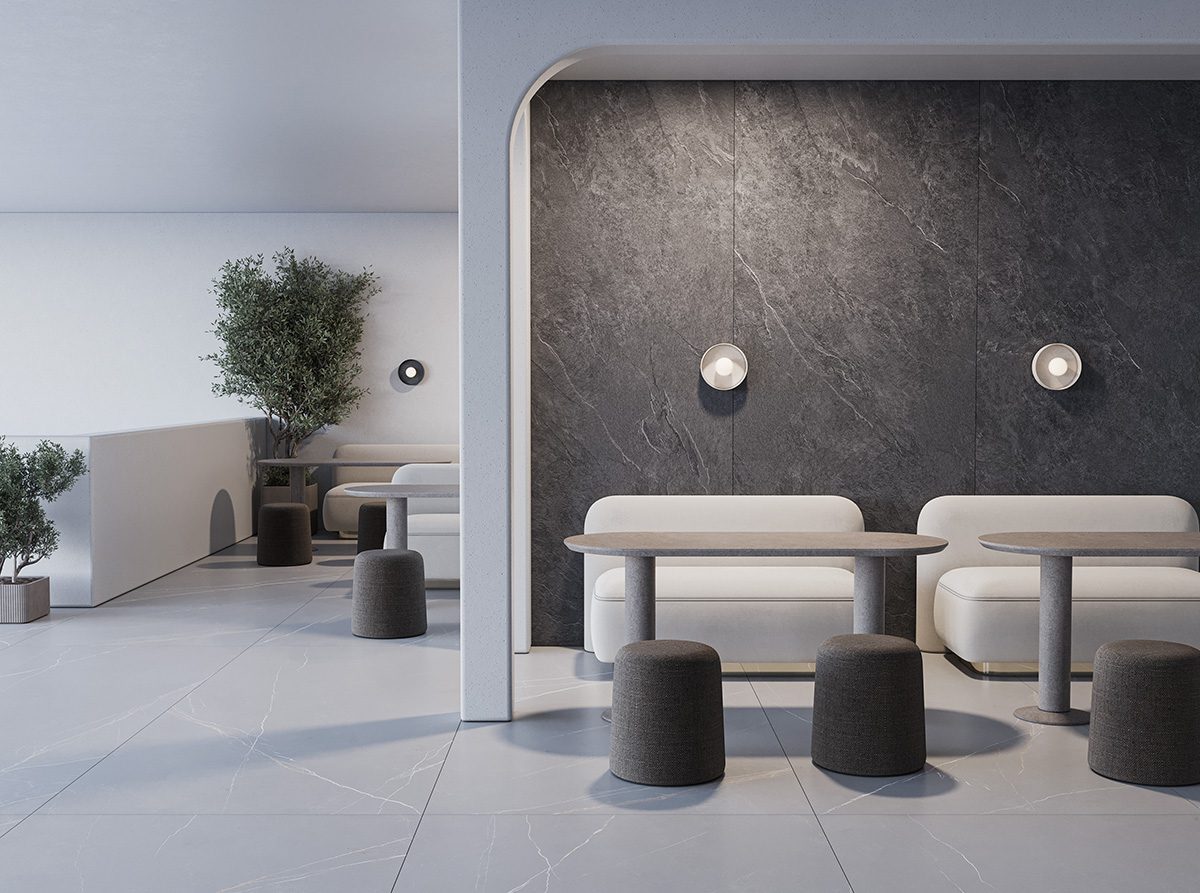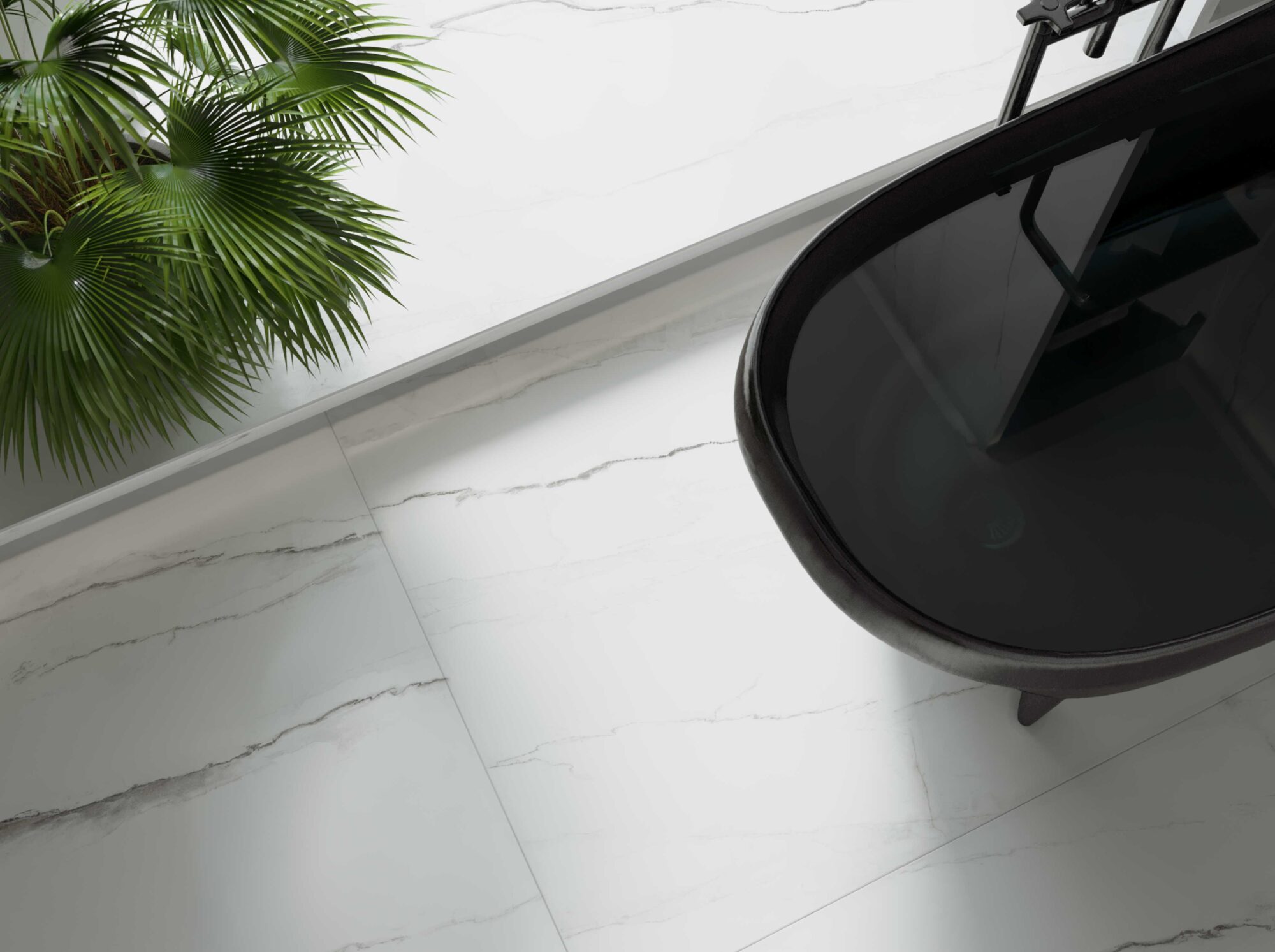Various Dimensions of Porcelain Ceramics
Porcelain ceramics, in addition to beautiful and diverse designs, also come in various dimensions and sizes. When selecting and ordering porcelain ceramics for different applications, attention to dimensions and size is of great importance. For instance, porcelain ceramics used on the floor are subject to more stress than other ceramics. Mainly, porcelain ceramics used as flooring in high foot traffic areas must possess more significant shear and bending strength, as well as higher abrasion resistance, to consequently have a longer lifespan. Smaller-sized ceramics are commonly used for parking areas and hypermarkets.In addition, the grout lines between the ceramic tiles are a place where dirt can accumulate. The smaller the ceramic tiles, the more these grout lines increase, and the likelihood of the environment becoming contaminated is also greater.
 Dimensions of Porcelain Ceramics
Porcelain ceramics are available in the market in the following dimensions (the mentioned dimensions are in centimeters):
Dimensions of Porcelain Ceramics
Porcelain ceramics are available in the market in the following dimensions (the mentioned dimensions are in centimeters):
- 40×40
- 60×60
- 80×80
- 100×100
- 20×120
- 120×280

- 160×320

- 60×120
- 80×160
- 40×100
- 60×120
- 80×160
- 80×120
Read More: "What is Porcelain Tile; Its Types and Applications"
Porcelain Tile 60*60 The 60 by 60 porcelain tile, with its square shape, is favored by many designers. This size of porcelain tile not only provides a unique aesthetic but also imparts a special order to the space. Compared to its smaller counterparts, this porcelain tile is frequently utilized for flooring in different commercial and residential spaces. It can be found in both matte and glossy finishes in the market.
Use of 60*60 Porcelain Tile The 60*60 porcelain tile is one of the choices for floor tiling. This tile offers the possibility to be used in high-traffic areas, including parking lots and hypermarkets.
Price of 60*60 Porcelain Tile The 60*60 porcelain tile comes in various designs, and the price for the 60*60 porcelain tile varies based on the quality of raw materials used, the brand of porcelain tile, color, pattern, and surface glaze. External factors such as currency exchange rates and market fluctuations also impact the price. Advantages and Disadvantages of 60*60 Porcelain Tile One of the most significant benefits of the 6060 porcelain tile is its extensive range of applications. Suitable for kitchens, parking areas, office spaces, restaurants, reception halls, shops, exhibitions, hotels, coffee houses, lobbies, and villas, it's a versatile option. However, there's a noticeable drawback to using this tile: the presence of numerous grout lines requires additional grouting material, leading to increased accumulation of dirt. This factor makes maintaining the cleanliness of these surfaces more demanding.
Limitations of 6060 Porcelain Tile Porcelain tile in the 60*60 size has no limitations for use. Unlike other sizes, this porcelain tile is suitable and efficient for spaces with either large or small square footage. Furthermore, the 60*60 floor tile, due to its smaller dimensions, is more affordably priced.
Read More: "Introduction and Purchase of Building Floor Ceramics" Porcelain Ceramic 60*120 Usage of Porcelain Ceramic 60120 Porcelain ceramic flooring of 60 by 120 can be utilized as floor covering for various types of surfaces, including the floors of halls, living and reception rooms, bedrooms, kitchens, restrooms, and bathrooms, as well as restaurant and coffee shop floors and hospital floors. Additionally, one of the most suitable dimensions for exterior building facade porcelain ceramics is the 60*120 size, which is used for the building's external facade.
Price of Porcelain Ceramic 60*120 The price of porcelain ceramics varies according to different designs, but the most significant factor affecting the price differences is the brand of porcelain ceramic. The higher the quality of raw materials, the manufacturing process, and the conditions related to the Quality Control (QC) unit of the porcelain ceramic in the 60*120 size, the higher the price will be. For information on the price of 60*120 porcelain ceramic from the pma brand, you can refer to our products page.
Advantages and Disadvantages of Porcelain Ceramic 60120 First of all, the larger the ceramic, the fewer grout lines in the installation space, which makes the environment look more expansive, seamless, and unified. Secondly, fewer joints and connection points mean less accumulation of dirt, making the area easier to clean. Larger ceramics offer diverse designs, and you can also order the specific design you want for production. Lastly, using porcelain ceramic of 120*60 size imparts a chic and luxurious appearance to different parts of the building. Fortunately, large-sized ceramics do not have significant drawbacks. Perhaps the only drawback is the challenging transportation and the need for careful installation. The greater the dimensions of the porcelain tile, the more the unevenness of the mortar bed will be noticeable. Therefore, for the installation of large-size tiles, the levelness of the surface must be controlled with greater rigor.
Limitations of Porcelain Tile 60*120 Large-size porcelain tiles have minimal limitations. The only constraint they may have is the need for cutting in some applications. For instance, you might be fond of a particular design, and for use in areas such as countertops, kitchen islands, and cabinet surfaces, you may be obliged to alter the dimensions. In this case, you must cut the porcelain tile of size 60*120 with specialized devices, such as waterjets and ceramic cutting tables, to the desired size.
Read More: Introduction and Purchase of Building Exterior Tiles Porcelain Tile 40*120 Applications of Porcelain Tile 40*120 The porcelain tile of size 40*120 is one of the products that can be used to cover the surfaces of floors and walls. However, due to its specific dimensions, this tile is more commonly used as a wall tile. The applications of this size of porcelain tile include areas such as kitchens, bathrooms, living rooms, and building exteriors.
Price of Porcelain Tile 40*120 The price of this porcelain tile varies significantly based on the brand. Besides quality, the size of the tile may also have a substantial effect on the project's cost. While larger tiles may be more expensive, in some instances, they may reduce installation and repair costs due to a decrease in the number of grout lines and a reduced need for as many tile pieces.
Advantages and Disadvantages of Porcelain Tile 40*120 Porcelain tile with dimensions of 12040 is considered a large tile and possesses numerous advantages. Large porcelain tiles offer greater possibilities for creating beautiful and varied designs. The use of large-sized porcelain tiles can induce a sense of spaciousness in smaller areas. Similar to the porcelain tile 60120, the installation of this porcelain tile is also easier and faster, as the reduction in the number of grout lines between tile pieces decreases both time and cost of installation. Moreover, due to the fewer grout lines and repairable areas, porcelain tiles with large dimensions provide easier maintenance and cleaning.
Limitations of Porcelain Tile 40*120 The use of porcelain tile with dimensions of 40*120 not only lacks any specific limitations; instead, it becomes one of the reasons for the special and unique appearance of the facade and walls, contributing to a unified look in the environment.
Summary In this article, we became acquainted with the dimensions of porcelain tiles for various applications. Choosing the size of the tile depends on your taste, project needs, and your budget. For example, if you are looking for a classic appearance and texture, smaller tiles may be the best option. If you are looking for a modern and simple design, larger tiles may be more suitable for you. In any case, you should choose a tile that is suitable for your specific project. To more easily and properly select the porcelain tile you need, you can take advantage of the guidance from our experts.
Q & A
1- Are there differences in using porcelain tiles of various sizes? In addition to that, the grout lines between tiles are a place where dirt accumulates. The smaller the tiles, the more these grout lines increase, and the likelihood of the environment becoming contaminated is also greater.
2- What is the most common size of porcelain tile for use in facades? The most common dimensions for facade tiles are 60*120 size, which is used for both interior and exterior walls.
3- On what basis should we choose the dimensions of the tiles? The choice of tile size depends on your taste, project needs, and your budget. Before choosing the tiles, you should carefully review the needs of your project and select the appropriate size based on the location, traffic, appearance, and cost. Also, you should use quality tiles that comply with the necessary standards.
